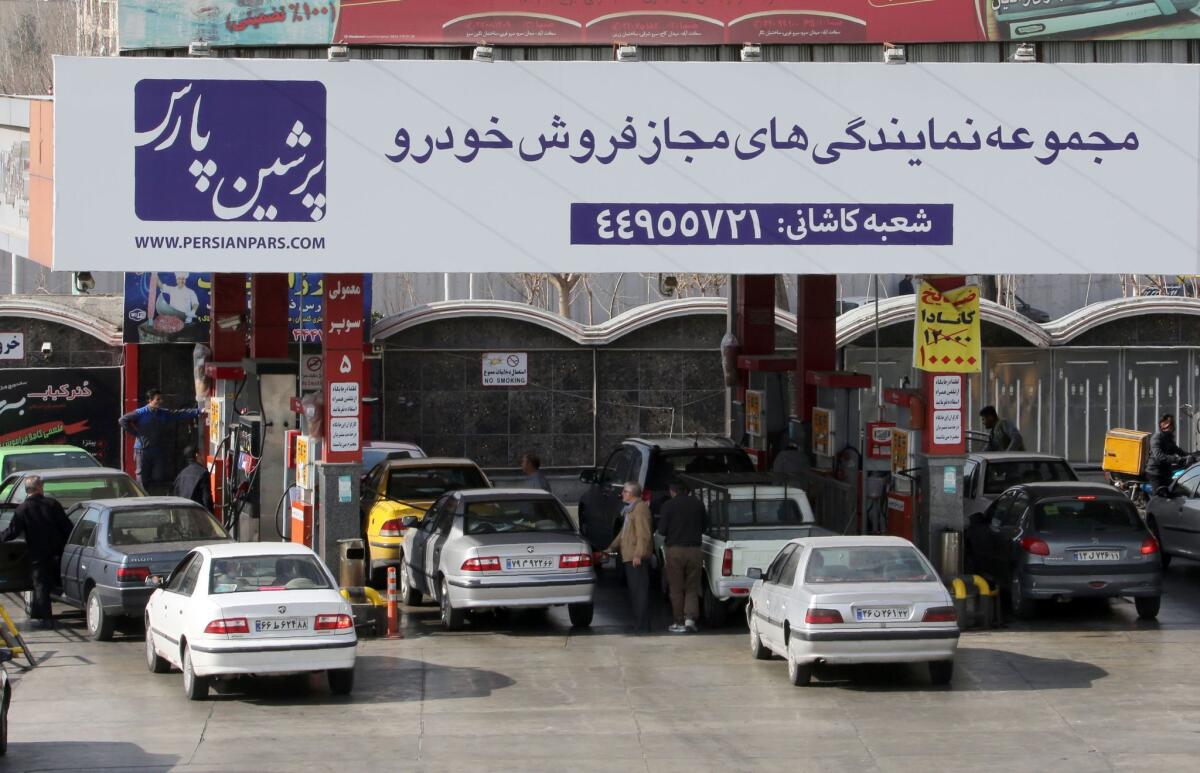Why markets are anxious about Iran’s reentry into the global economy

Iranian motorists fill up at a gas station in the capital, Tehran, on Jan. 19, 2016.
Reporting from Washington — After years of sanctions and isolation, Iran’s return to the international marketplace should be a welcomed boost for a global economy desperate for good news. The country is rich in natural resources and has a large, mostly urban population of young consumers.
But the opening of Iran’s economy, following the lifting of nuclear-related sanctions last weekend, is being met with considerable skepticism and trepidation, especially in the U.S., where the stock market on Wednesday suffered one of its roughest days in months.
The biggest immediate economic concern is that Iran’s reentry will exacerbate the global oil glut. Iran has the world’s second-largest reserves of natural gas and the fourth-largest deposits of petroleum.
See more of our top stories on Facebook >>
Since the U.S. and European Union sanctions were imposed in 2011-12, the country has produced on average roughly 3 million barrels of oil a day, although it was able to export less than half that amount in recent years. Some of that excess supply has been stored in tankers, and Iranian officials have said their plan is to ramp up production and ship an additional 500,000 barrels a day.
That may not seem like a lot in a world that on a typical day consumes more than 90 million barrels of oil and petroleum products. But the expected addition from Iran couldn’t come at a worse time.
Heavy U.S. production of shale oil in recent years and persistent pumping by major suppliers such as Saudi Arabia have kept building up petroleum stockpiles. Worldwide oil supplies exceeded consumption by about 1.5 million barrels a day at the end of last year, according to the U.S. Energy Information Administration. That excess inventory is forecast to grow to more than two million barrels a day on average this year, thanks in good part to Iran’s return.
With foreign investment and modernized infrastructure, Iran could crank up its aging fields more quickly and deliver as much as a million more barrels of oil a day within a year, said Gary Hufbauer, senior fellow at the Peterson Institute for International Economics.
Either way, Iran’s return has added another unpredictable ingredient to stock markets already anxious about uncertain growth in China and the strong dollar. Eighteen months ago, a barrel of crude was trading at more than $100, but it’s since fallen to less than $27, with U.S. oil futures tumbling to the lowest since 2003.
Oil prices slid further on Wednesday, extending the stock market rout that began at the start of the year. The Dow Jones industrial average closed down 1.56%, after falling twice that much earlier in the day, and is now off 11% since late December, a correction in Wall Street parlance. Japan, meanwhile, entered bear-market territory Wednesday with declines of 20% or more from a recent high, following similar declines in Chinese markets.
For the U.S., there is an upside in the sinking gasoline futures: Motor fuel prices already have fallen sharply, to below $2 a gallon nationwide, on average. There will be extra savings this winter for consumers in the Northeast and other parts of the country who heat their homes with oil.
Yet more pain lies ahead for U.S. energy businesses and workers, especially in big fracking states such as North Dakota and Texas as oil companies further curtail investments and costs, including for staffing. On net, most analysts reckon the depressed oil prices will be a wash for the American economy or modestly positive, since it relies primarily on consumer spending as the engine of growth.
Iran’s new economic freedoms more broadly will have limited impact on the U.S. for the foreseeable future, even though many see Iran as one of the last major economies to open.
The removal of sanctions will give Tehran access to tens of billions of dollars of once-frozen assets for much-needed investments to improve basic infrastructure. And undoubtedly there’s great market potential. Iran has a diversified economy with a population of 80 million that is relatively well-educated, especially in math and sciences.
Despite sanctions, Iran’s gross domestic product of about $17,000 per person is greater than Brazil’s and China’s, and it has one of the lowest public debt ratios in the world, according to attorney Cyrus Amir-Mokri and Hamid Biglari, a former U.S. Treasury official for financial institutions, writing in the journal Foreign Affairs. Before the sanctions in 2011, they said, Iran was the world’s 13th-largest maker of automobiles, more than Britain.
With the international restrictions lifted, Iran’s economy is likely to grow 3.5% this year, the second fastest in the region and a striking contrast to its 6.6% contraction in 2012, said Bryan Plamondon, senior manager for Middle East and North Africa research at IHS Global Insight.
Among those outside Iran benefiting the most, he said, are people in places like Dubai, a short distance across the Persian Gulf where hundreds of thousands of Iranians are living and working. Joining them will be a host of Western European companies. German automotive firm Daimler and the French hotelier Accor are among some that already have moved to restart or open businesses in Iran. European trade missions to Iran are being planned, and China’s president, Xi Jinping, is set to visit Tehran next week, at which time economic deals could be announced.
“It’s a big boost for Iran,” said Plamondon, although he added that red tape, corruption, poor intellectual property rights protection and other long-standing issues have tempered the enthusiasm. In addition, there are risks that sanctions could be reimposed should Tehran fall out of compliance on its nuclear agreement.
For the U.S., there won’t be any rush to Iran. Apart from the business and political concerns, American companies and individuals, with few exceptions, are blocked by the 1995 U.S. trade embargo on Iran from engaging in dealings with Iran or its government. In the early 1990s American exports to Iran topped $600 million, but in recent years shipments, mostly grains, have totaled less than half that. Even non-Americans remain barred from transactions or activities that support export of goods or services from the U.S. to Iran.
That means whatever jackpot there is to be had from Iran’s commercial return, at least in the short term, will be largely divvied up between European and Asian businesses and investors, said D.E. Wilson, an attorney at the firm Venable and former acting general counsel of the Treasury Department.
“People seem to think the world has now changed,” he said of some of hype over the new business opportunities in Iran. For Americans, he said, “it hasn’t.”
Follow me on Twitter @dleelatimes
ALSO
Stocks recover a bit after Dow plunges more than 550 points
Are any of the Iranians in the prisoner swap a threat to national security?
Iranian Americans’ views on the Iran deal often fall along generational lines
More to Read
Inside the business of entertainment
The Wide Shot brings you news, analysis and insights on everything from streaming wars to production — and what it all means for the future.
You may occasionally receive promotional content from the Los Angeles Times.











